The Snakepit, the Harp and Högni's Heart
by Peter Krüger
©2013
[Germanic Astronomy]
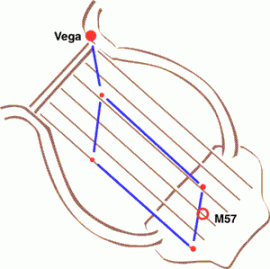 |
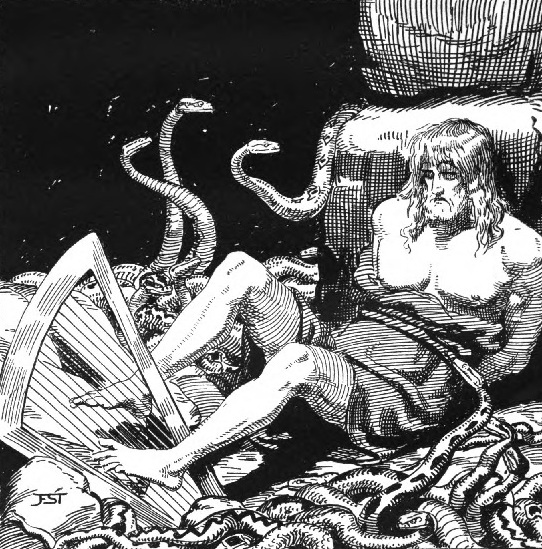 |
 |
In the Dráp Niflunga and related tales we find a story about the death of Gunnarr and Högni that is quite different of the Nibelungenlied version. It describes how Gunnar and Högni come to the hall of Atli who is married with her sister Gudrun and how they are captured and killed. Gunnarr is said to have been thrown into a snakepit, playing a harp there (according to Atlakvida with his feet).
The theme: hero, pit
and snake ('ormr') sounds
familiar. I explained the fight of Sigurd,
sitting in a pit, with the ormr Fafnir as a depiction of the
constellation Hercules, kneeling (!) next to the pentagonal asterism of
Ophiuchus - being the pit - being surrounded by the constellation of the
'ormr' of Serpens.
But why is Gunnarr playing a harp
with his feet? A look at a star map easily solves the mystery. Next to
the feet of Hercules we find the constellation of Lyra, the lyre or
harp!
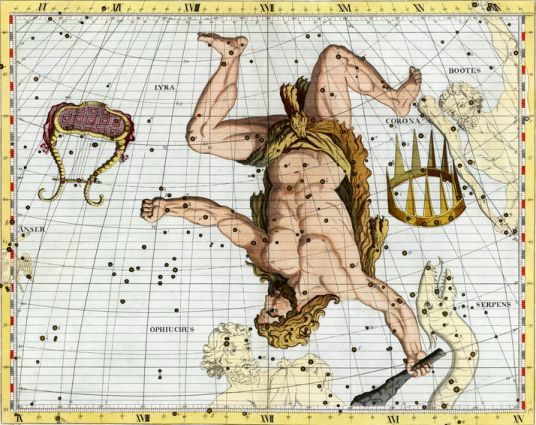
But if the description of
Gunnar's death is depicted in the stars, what about the strong heart of
Högni, cut out of his body? Interestingly this is not the only time that
we find a strong heart mentioned in Eddic tales, i.e. after the
slaughtering of Hrungnir by Thor his heart of stone is explicitly
mentioned. Björn Jonsson identified it with the asterism of the teapot,
a part of the constellation of Sagittarius, the archer.
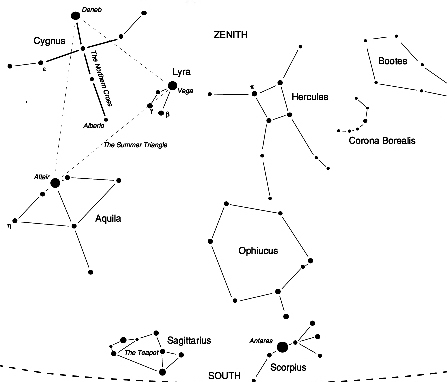
Now it is getting really interesting: Hercules, the kneeling man I identified in another post also with Wayland/Völund with his sinews cut on behalf of king Nidhad/Nidud. According to Deor's lament Wayland is sitting between worms/snakes.
Also the brother of Völund, the
famous archer Egil (Sagittarius) was according to Thidrekssaga at the
court of Nidhad/Nidung.
This means that the pair of brothers
Gunnarr and Högni correspond to the pair of brothers Völund and Egil of
the Völund cycle. I assume therefore that also Nidhad/Nidud (depicted as
the constellation of Böotes) corresponds to king Atli. The daughter of
Nidud, Bödvild, the constellation Virgo, the virgin than surely
corrspond to Gudrun. Note that also in both cases the king has two sons
that are slaughtered. Note also that the king in both cases has been
greedy for the gold of Völund or the Niflunga hoard respectively.
As a summary we find two
quite different tales, both written from unknown poets into the same set
of constellations!
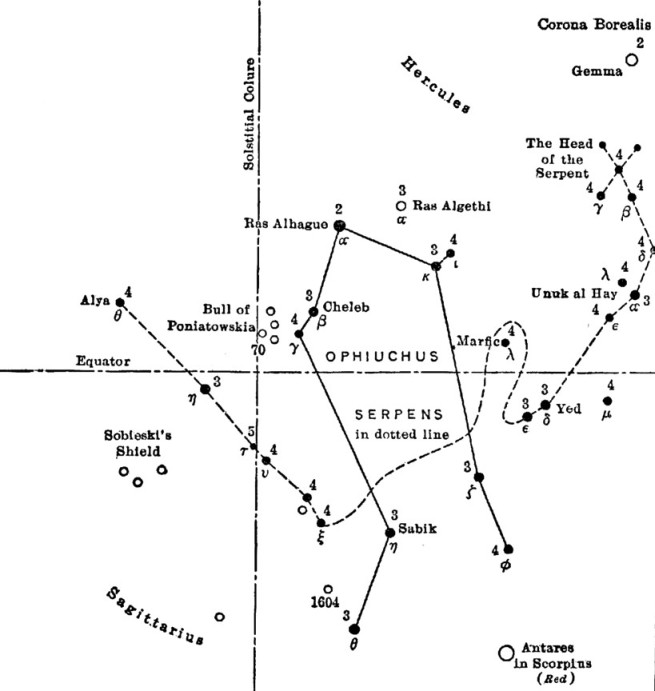
I would like to point out another interesting thing in the Dráp Niflunga. It is the use of the words 'ormr' and 'nadr' in comparison to Völuspá:
| Hiarta var scorit or Hagna, enn Gvnnarr settr i ormgarð. Hann slo horpo oc svefþi ormana, en nadra stacc hann til lifrar. (S. Bugge) | "Hogni's heart was cut out, and Gunnar was cast into the serpent's den. He smote on the harp and put the serpents to sleep, but an adder stung him in the liver." (Bellows) |
In my interpretation below I identified Högni's heart with the asterism of the Teapot in Sagittarius, Gunnar with the constellation Hercules (Greek Engonasin: the kneeling man), playing a harp (constellation Lyra) whilst laying in the snakepit (ormgard = the space of Ophiuchus, surrounded by the constellation Serpens). But what about the adder?
I assume that in the
used picture the adder is to be seen independent from the constellation
Serpens below Hercules/Gunnar. In contrast it is the constellation
Drago, the dragon, hanging above Hercules/Gunnar. This explains
astronomically why this adder is not put to sleep: in contrast to
Serpens being put to sleep (=setting at the western horizon before
Hercules) the constellation Drago is one of the never setting
constellations!
The interesting point is that we
find a parallel of the pair of ormr / nadr in Völuspá.
And indeed the word nadr appears in the context of a dragon:
—(Bellows tr.)
—(Bellows tr.)
Þar kemr inn dimmi
dreki fljúgandi,
naðr fránn, neðan
frá Niðafjöllum
Then comes the dusky
dragon (=Drago) flying,
a gleaming serpent, up
from Niðafjöll;
The word ormr, in
contrast, seems clearly to refer to the constellation of Serpens and
Ophiuchus, also seen as a kind of snakepit in Völuspá:
Sal sá hon standa
sólu fjarri
Náströndu á,
norðr horfa dyrr;
falla eitrdropar
inn um ljóra,
sá er undinn salr
orma hryggjum.
A hall she saw standing
far from the sun,
on Náströnd,
the door facing north
(=the door shaped asterism within
Ophiuchus);
drops of poison fall
(= a reference to Serpens Caput)
in through the
smoke-hole,
that hall is woven
of the backs of serpents
(=Serpens).
ormr knýr unnir,
en ari hlakkar
"the serpent (=Serpens) churns the
waves, and the eagle (=Aquila) screams"
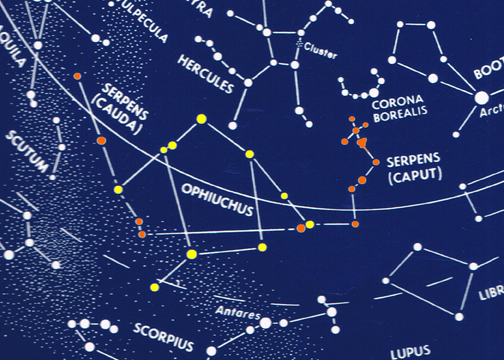
Some additional considerations in the context of the Dráp
Niflunga:
Shortly after the death of Högni, Gudrun kills Erp and Eitil,
the two sons of Atli. This may refer to the setting of the
constellation Gemini, the Twins, at the time of the rising of
Sagittarius/Högni's heart.
Atli/Böotes drinks from a cup made from the head of his sons,
this is Corona Borealis,the Northern Crown, next to Böotes.
Gudrun mortally stabbed Atli with a sword; the sword is a
reference to Antares, the main star of Böotes.
Gudrun sets fire to the hall of Atli, I assume the source of the
fire is the rising constellation Ara, the altar. Then Gudrun
went to the sea to drown herself but crosses the fjord and comes
to king Jonaker. The sea is the water region of heaven with
Capricornus, the goatfish, Delphin and Aquarius. And indeed
Jonaker is either Capricornus or Aquarius, but this requires a
separate analysis.
In this tale, the ring Andvaranaut is also mentioned. Attached
to it is a wolf's hair. In another post I identified the
Andvaranaut and Draupnir with the asterism of the Circlet in the
western Fish of Pisces. The line of 8 stars between the Circlet
and the star Al-risha are both the eight stars "dropping out" of
Draupnir and the wolf's hair attached to the ring.
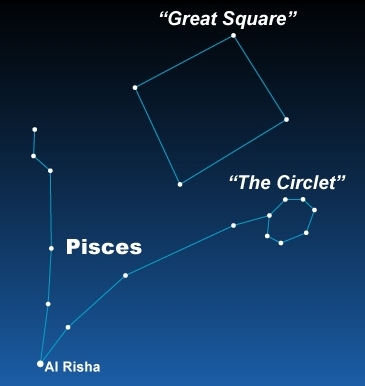
[Germanic Astronomy]